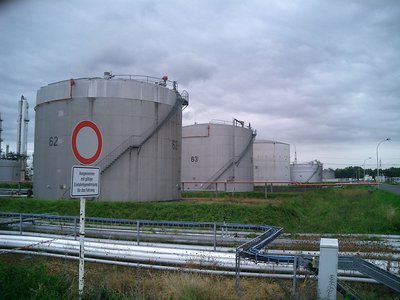Oil refinery well isolated
Tuesday, 16 April, 2013
In process plants with explosive areas, intrinsically safe (Ex-i) interfaces form a bridge between the control centre and the installed field sensors and actuators. The primary task of Ex-i signal isolators is to safely limit the energy conducted into the Ex area to an amount that is below the minimum ignition threshold of the surrounding explosive atmosphere. According to the design specifications of the EN 60079-11 standard for intrinsically safe explosion protection, these signal isolators need to ensure that all the parameters affecting intrinsic safety - such as the maximum no-load voltage, maximum short circuit current and maximum power - are adhered to even during malfunctions.

As part of ongoing plant upgrades, Oil Refinery Oberrhein (MiRO) has recently introduced a new automation solution in its blending plant. One of the changes was to replace the Blend Ratio Control concept (BRC) with an Experion Blend Controller system (EBC) from Honeywell. This changeover entailed replacing the control system’s I/O level, which is located in the central switchgear room. For the functional specification of the Ex-i interface level, which was also being upgraded, the MCR planners defined the following main goals:
- Lowest possible component width so that there is minimal use of control room space, with ample spare room for future system extensions.
- Less product diversity in order to minimise warehousing and documentation costs.
- Suitability for safety-oriented measuring and control circuits.
Following a period of extensive testing of Ex-i solutions, the planners decided that the MACX Ex products from Phoenix Contact were best suited to their requirements. No matter if it’s single-channel or dual-channel HART-compliant repeater power supplies and output isolating amplifiers, NAMUR switching amplifiers, signal duplicators, solenoid drivers or temperature transducers, all MACX Analog Ex modules are just 12.5 mm wide. This means that up to 45% less space is used on the mounting rail compared to the usual module widths of 16-22.5 mm.
The MACX analog Ex interfaces have been developed for use in safety-oriented circuits that comply with EN 61508 and have been certified accordingly by external inspectors such as TÜV Rheinland. The interfaces all qualify for SIL 2, some even for SIL 3.
The 30 decentralised blender stations located at MiRO’s Karlsruhe plant are classed as Ex zone 1 and in parts as Ex zone 0. The field instruments, which consist of various flow meters and HART-capable 4-20 mA control and separator valves, are required to provide intrinsically safe explosion protection. The blending process also entails pump control and the analysis of tank level gauges, signalling contacts and 4-20 mA signals coming from the analysis station’s two-wire transmitters. The field instruments themselves were not exchanged as part of the plant upgrade. The signals’ point-to-point connections are provided via four-core cables up to 600 metres long. These start at the honeycomb routing terminals located in the blending plant’s central distribution station. From this station, the signals are directly routed to the Ex i isolator level, where they are passed through approximately 750 analog Ex signal isolators and then processed via C200 and C300 controllers.

The Ex i isolators are arranged into device groups of 16 and mounted in open routing frames on DIN rails. The frames, which are built in-house at MiRO, have a very compact design and are easy to maintain, so the small form factor of the MACX isolators made them perfectly suited.
Highly precise signal processing is crucial for proper operation. Rolf Bechtold, Project Engineer in Automation Technology at MiRO, confirms the MACX devices’ excellent signal quality: “The isolating amplifiers with transistor outputs, used for analysing the counter pulses, convinced me due to their clean edges. So far, we have not encountered any processing issues with the C200 counter cards from Honeywell.” Bechtold adds, “The MACX isolators can be used flexibly and cover all our requirements with a manageable number of product types. This is an important advantage in terms of device standardisation.”
The MACX MCR-EX-SL-RPSSI-I Ex-i repeater power supply offers a supply Ex-i input for two-wire transmitters to convert signals from the analysis station and also a non-supply Ex-i input for the 4-20 mA signals from the flow meters. The device passes on the HART-transparent 0/4-20 mA signals to the passive and active analog C300 input cards. Says Bechtold: “This flexibility was fantastic for migration within a running system, and it also provides a number of advantages for wiring. Again, it is very useful to us that the isolating amplifiers feature two relay or transistor outputs. Thanks to the MACX devices’ Ex properties, we were able to retain all of our field instruments. This would have been much less straightforward using any other range of Ex isolators available on the market today.”
The MACX Analog Ex isolators turned out to be a perfect match for MiRO’s requirements. This is proven by how well the blender upgrade has been performing in production over the past 18 months.
Liberating stranded data via the IIoT
Modern edge-to-cloud IIoT solutions can make it easier to access and use stranded data.
How the IIoT can fast-track Australia's sovereign manufacturing capability
The primary benefit of using automation to enhance sovereign capability is increased productivity...
EtherCAT: leveraging industrial Ethernet for 20 years
EtherCAT is the only industrial fieldbus that leverages Ethernet for both high speed and...














